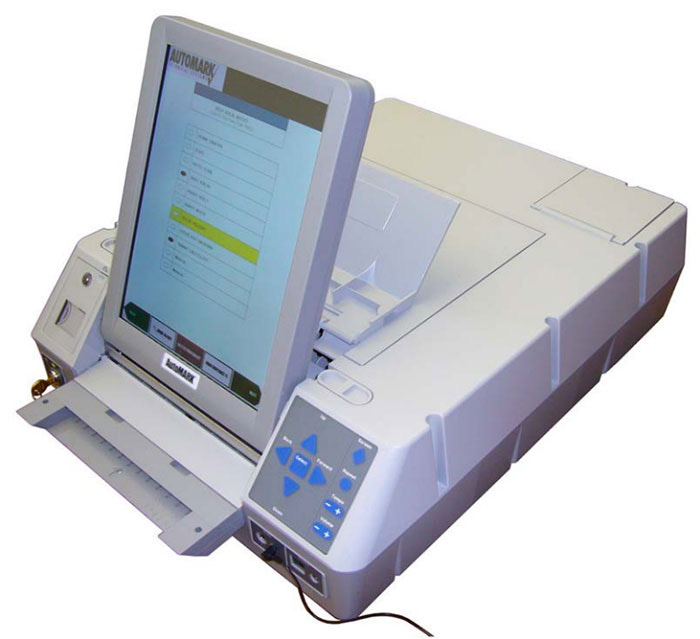Designing a Secure Voting Machine
It's simple, if people actually wanted a secure voting machine.
What You’re Not Allowed to Say
Since the beginning of time, voting time, elections have been rigged. Every election for every candidate, in every country, for everything, ever. Deal with it.
2 corrupt sides battle it out and the most corrupt usually wins. Incompetence plays a part too. Tens of thousands of votes for a single candidate can’t be submitted at the same time, that’s too suspicious and would be found out. Actually you can, you will be found out but no one will care because you bribed the right people. Voting is complicated!
Even before easily exploitable voting machines, people were physically bussed in to key areas and voted en masse for whom they were told. Those with no interest in voting were bribed and transported to voting stations by interested parties. Decades old dead people vote from beyond the grave. All proven facts throughout history. There is no such thing as a democracy.
Not that I give the slightest of fucks about naming and shaming, I have literally nothing to lose if sued, but we all know the parties who create and exploit existing systems. There’s no need for yet another article reiterating the obvious.
There will never be a 100% secure voting system. At some point in the chain, a human will be involved with the opportunity to corrupt data. Current systems rely heavily on humans and that’s the problem. More humans, more chance of corruption, less ability to the determine point of failure. Automation isn’t much better as that’s written by humans. Same problem, however machines can be independently audited. Humans lie.
I’ve read articles putting forth arguments for crypto, blockchain and Internet voting. Presumably the authors were higher than Hunter Biden. Less complexity is needed, not more. Definitely not a complex system open to the Internet. Complexity and an open network equal more vulnerabilities. That’s batshit crazy and security should be the number 1 priority. Once a system is secure, result auditing becomes the focus.
What’s needed is a fully autonomous system, using templates, open source, with anonymised data that any member of the public can query. Reusable, at minimal cost, with no onsite setup. Simple.
I have no connections to any security individuals, companies or product manufacturers. No agenda or motive. Beyond ending this onslaught of corruption arguments plaguing my news feed for years after every fucking election.
Some Current Voting System Concerns
A few years ago I ran across an archive on GitHub, of all places, containing documents highlighting vulnerabilities in voting machines. They’re compiled from various sources and are quite scary.
The archive disappeared one day without explanation. Did the owner remove it or was it taken down? Despite what you may have heard, the Internet isn’t forever. The 200TB’s of backup drives I have behind me, are. Until I die and some clueless idiot wipes them. Hopefully that won’t before I finish writing this post.
Documents are linked below from my Google Drive account, so they should be there for a long time. Don’t be dissuaded by the technical aspect. I think they’re simple enough for anyone to understand? Most of them appear to be written for business types.
We’re not focusing on Dominion. These machines are from various manufacturers at different times…
Defcon27-Voting-Results-page-18-is-Dominion.pdf
Though DEF CON has been flooded with normies and hacks over recent years, this is still quite revealing and the one you should read
Dominion-GA-Pilot_resultsExecutive_Summary_Initial_Findings_Pilots_11-14-19.pdf
GA-Brief_request_not_use-Dominion_20191023-640_1-Coalition-Brief-Supporting-MPI.pdf
PA-Examination-Results-Dominion Democracy Suite Final Report scanned with signature 020119.pdf
Texas-Analysis-Dominion-Failed-to-Protect-Votes-dominion-democracy-suite-5.5.pdf
What these documents reveal is a staggering lack of competency or corruption. Likely both. Contracts given to either major political party donors, that’s a bribe, or the lowest bidder. Again, almost definitely both.
Everything is broken and exploitable with current implementations. Meanwhile these machines are being used to decide the fates of actual countries, with clowns on fake news networks like CNN proclaiming them safe and secure. Bullshit.
Below is an excerpt, a personal favourite, from page 14 of the document Defcon27-Voting-Results-page-18-is-Dominion.pdf
The ES&S Automark is a ballot marking device that allows keyboard and ethernet ports to be plugged in after removing the top of the machine’s case. The casing is closed only by 3 screws and does not include any tamper-evident seals. Immediate root access to the device was available simply by hitting the Windows key on the keyboard.
The lock to this device can be picked manually, allowing root and physical access to the unencrypted drive.
A RJ45 jack appears to be hidden behind a sticker on the front of the machine, accessible by removing the sticker without any tools.
The ES&S Au toMARK runs Windows CE Embedded Operating System 5.0. The application software in the machine appears to be last updated around the end of 2007, and the system appears to have been last used in a special election in late 2018.
No words.
I’ve seen more secure self-scan checkouts at supermarkets. Unacceptable. That is not a ballot marking device. It appears to be some re-branded off the shelf tech, sold at 10x it’s value to idiots in the government. People who don’t know what they’re doing, don’t care who it impacts, because their corrupt families are set for life.
Why does it have ethernet ports at all? Why does it even have drivers to power ethernet ports? These machines should be air gapped. Why not? Nuclear reactors and other secure government systems are air gapped to prevent unauthorised access. If a device is not networked, how is data sent and retrieved? Easily. I’ll explain in my design.
Unencrypted drives. Possibly the simplest software security to implement. All of my drives are encrypted and the most important documents they contain are for my shit books I’ll never publish.
I’m not overly concerned with the lack of operating system updates. There should be no way to access the software. By the time someone did, the machine should already have measures in place to alert of possible fraud. Anyone implicated in interference is arrested and sent to prison.
More concerning is the use of Windows CE 5.0. Why isn’t there a minimalised, custom built operating system? The government doesn’t have enough money to fund such a project? What about Temple OS? In 2023 the US government gave NASA $25,400,000,000 dollars just to Photoshop pictures of space. The money is out there.
That’s 1 page from 1 document. It doesn’t get better.
These machines, the entire election process, needs redesigning from the ground up.
What Does and Doesn’t a Voting Machine Need?
Need: Single secure premises for configuring and storing machines
A permanent, secure building with highly restricted personnel.
CCTV monitored with live streaming accessible by the general public.
Obviously hide sensitive data.
Armed guards everywhere.
Everything to be performed on these premises.
Components obviously built offsite.
Hardware and software do not get touched off the secure premises, ever.
No wi-fi on site.
Don’t Need: Paper ballots
Massive red flag. Employees should be fired for even contemplating such a moronic idea.
Paper ballots are for ballot harvesting and fraud.
Have you seen all those officials standing around doing nothing at voting stations? In a single evening they could drive around town, park up in the street so voters can walk up and use a secure system. Like an ice cream truck. Maybe give away ice cream!
For the very few disabled people who can’t make their way 20 feet in to the street, wheel the machine to their door. Portable.
Need: In person voting
Every person needs to manually key in their own vote.
Don’t care where they are in the country, where they are in the world, what job they do.
If they’re too lazy to vote, they don’t get to vote.
If I can send a computer halfway around the world within a couple of days, a government can do the same with a few voting machines and guards.
The only exception is for the visually impaired.
No extra tech to accommodate them because it’s impossible to secure.
The person will be accompanied by officials representing each party, in the voting both with them to guide the process. Dogs are allowed.
If they’re too scared to tell people who they voted for, they shouldn’t be voting.
I think everyone’s vote should be publicised, but am well aware that 99% of people in the world are cowards.
If people are too stupid to use a voting machine, they’re too stupid to vote.
Put a single A4 sign above the voting machine stating “Read the screen, dent head”
Need: More, better, tamper security
Priority to implement.
Something better than a sticker.
No screws, no complex locking mechanisms, keep it simple.
Single use tabs which break if forced or the device is opened.
This won’t stop fraud but will flag all ballots as requiring review.
Cases to be sealed at secure premises before being sent out.
Cases can be X-ray scanned before and after entering the facility, with results compared for integrity.
Don’t Need: Software updates outside of secure premises
The system saves a picture and some text to a database.
It also stores the names of running parties which are known months in advance.
What needs updating?
Nothing.
Don’t Need: open source software
Sounds like a security issue, it’s quite the opposite.
Open source software can be audited by the public so everyone is assured of election integrity.
Current machines are using Windows…
Are people so deluded today that they believe Windows is more secure than a stripped down, open source custom operating system?
If this is you, stop reading.
Don’t Need: External ports for anything
All data should be processed at the secure facility, so remove all ports.
No ethernet ports.
No wireless tech.
No sensors.
No USB ports.
No power switch.
The only point of entry is a touchscreen.
Need: A large touchscreen
Security molded in to the device
It’s still reusable
This is the only interactive component and it has almost no options.
Even when set to developer mode, then it’s controlled by keyboard
…and mouse, if you have to
Thick glass so it’s hard to damage
Need: A camera
Constantly recording footage for later analysis if an issue occurs
Takes a still picture of the person voting for verification and stores it in a database
Need: Internal speaker
To alert voting stations as to issues.
Loud enough to be heard from inside the shell, there are no vents or holes
Similar sort of design to a regular desktop PC:
Continue beep = power supply interrupted
Single pulsing beep = CPU issue
Two pulsing beeps = RAM issue
…
Need: Portable power supply
For remote voting.
NOT USB.
Any generic generator or battery which accepts standard plugs.
Need: Small internal power supply
To complete current processing if mains power is interrupted.
Don’t Need: Election interference
1 person in the voting booth at a time.
Unless visually impaired then a helper from each party must be present.
No paper ballots.
No proxy voting.
Only the person present can vote, once.
Hard drives are taken from machines, put in a server, decrypted and results ingested.
Results can be anonymised and released to the public within minutes, infinitely quicker and more accurate than paper ballots.
Don’t Need: Political party donations
No party, or entity involved with a party, should be eligible to receive donations.
Any donations should render the party compromised and removed from the election.
Each party should receive:
Equal interview time on all platforms and events.
Equal advertisement time for all platforms and events.
Equal staffing.
All impartial and at government cost.
The public:
May wear badges, put stickers on their cars or signs around their property.
May sell or distribute campaign materials to other people or places.
All payment records are to be handed over to the government and audited, ensuring campaign stakeholders did not fund anything.
The individual will receive a 12 year prison sentence for election interference, per offence.
The party will be removed from the race.
Simple.
The New Process - Device Construction and Maintenance
Components are made offsite, assembled onsite. Larger components can be ID tagged per machine for added security. If the tags don’t match when a device is returned then there’s election interference. Bit overkill.
For every election a new shell and tamper tags are required. This is where money, the driving force behind most elections, can be made. There’s no reason to ever change the design, but it’s possible. The colours and designs of security measures can be changed every year? No legitimate reason to other than for making money.
In current systems, revenue is generated through hardware and software updates. These are 1 time costs for our proposed system. For every election new shells, security tabs and measures will need purchasing. So government officials can still siphon tax money for personal gain. There’s no way around it. Bad for tax payers, good for the government.
Once the shell is fully sealed, devices can not be opened until voting has completed. No hardware can be changed, no software updates. Any changes requires the seals to be broken, maintenance made and new seals reinstated.
Other than security measures, hardware should be reusable every year. However, given the ineptitude of the general public, I imagine some touchscreens will need replacing over time.
The New Process - Preparing Machines
Once built, machines should be wiped and placed in storage until needed. Once returned from a voting station, machines are processed, wiped and placed in storage.
When a machine is ready for deployment it should be wiped again to be sure, all relevant software reinstalled and nominees added. Then it’s sent to final testing. There’s a constant cycle of erasing, configuring, deployment, extraction and erasing…
Machines can be in 1 of 9 states:
New or existing, wiped
Prepared
In test
Ready to deploy
Waiting to be processed
Processing
Processed without issues
Processed with issues
Under investigation
Should be obvious what each state is. There are more states such as for shipping states; en route, arrived, delayed and so on. The list isn’t comprehensive, more of a quick overview. It’s not like any of this will ever be implemented.
A machine that’s been used in an election arrives at the facility, data is extracted, decrypted, analysed then either fed in to a master database or sent for fraud investigation.
The key aspect here is no data is sent across the Internet or stored on external media. Everything happens at the secure facility under guard.
The New Process - The Facility
All preparation and data analysis happens at a heavily guarded, secure facility. Armed guards inside and out, limited timed access, CCTV cameras everywhere.
There’s no reason why the majority of these cameras can’t be live streamed over the public Internet either. Obviously not the encryption process or toilets, but who cares if people know what colour the security seals are? They could out out by looking at the seals on devices at the voting stations.
This facility should be one of the most secure places in the country. The public should be able to see what’s going on, but have no direct interaction They can’t control cameras, contact personnel or visit for a tour. This is grown-up time.
Building a Machine - The Shell (important part)
The shell is intended to be the most secure part of out voting machine. This is where current technology catastrophically fails.
Existing machines emphasise security on the hardware and software levels. This will always be exploitable. As such, it becomes a money pit. Every year software and hardware ‘needs updating’ which funnels more lucrative government contracts to campaign donors at the expense of security. What would be the benefit of a company developing a 100% secure system? They’re dependent upon repeat business. Build it once, declare bankruptcy.
My shell design incorporates repeat business and even a little innovation. So there’s still money to be made while making elections more secure. But there’s the conundrum.
People are given government contracts in exchange for campaign funding and support, which results in a specific party being elected. If the election can’t be fraudulently won then the agreement falls apart. Why donate money on the slim chance it might affect something?
Let’s ignore the criminal aspect for the sake of this article and assume people are honest. HA!
The shell is a sealed compartment made of 2 parts; upper and lower. There’s a hole for the power cord and another for the touchscreen:
That leaves 3 points to be securely sealed; power cord, touchscreen (over the touchscreen so it can’t be removed) and the 2 shell sections. What’s to stop people breaching these areas and resealing them later?
The sealant comprises of multi-coloured waves. Due to randomness, these will be unique per seal on every device. No 2 patterns will be in exactly the same place.
Penetrative scanning. Let’s go with X-rays.
2 stabilisation devices are built to hold the voting machines in 6 specific positions; 1 for each side. 12 pictures are then taken of the device; 6 regular photographs and 6 X-rays.
The sealant and X-ray images are compared. If they’re not identical then the machine has been compromised. At which point results will be manually verified at the secure facility, prior to insertion in to the master database.
Now we can tell if the seals have been broken and they’re the only entry points in to the system. Sort of.
What’s to stop nefarious actors cutting a small hole in the case and filling it in? After all, it’s not a special material. For starters, armed poll guards should shoot them. But the these imperfections would show up on the X-ray and be flagged for review.
Couldn’t the shells be vandalised to illegitimise results? Sure. But if we’re manually comparing data on compromised machines, the results will still be authenticated. More than with paper ballots.
The authentication process involves officials contacting voters in person to corroborate votes and personal information. Arrests for election interference can be made on the spot with a 12 year prison sentence, no parole.
For each election, new shells and sealant would be required. Internal components, software, touchscreen, camera and power cord, can all be reused. With the shells being almost impossible to compromise, money is saved on redundant hardware and software updates. Especially with everything being custom and open source. That’s coming!
It’s not 100% secure, nothing is, but it’s the best and easiest solution to the problem. A problem no one is taking the slightest of interest in addressing.
What if a machine goes missing? Stolen by people who steal dumb shit? Perhaps a foreign power? Who cares. Everything is open source and it’s not like they can inject data in to the master database. Physical access would be needed to the secure facility and the tamper seals perfectly restored. That’s near impossible.
Building a Machine - The Components
Honestly, this thing could run on hardware marginally better than a Raspberry Pi. An old Dell Precision T1600 from 2010 would be more than enough; single-threaded quad core, 3+GHz, 16GB RAM. Can pick them up on eBay for less than a Pi. I run one as a low end server.
All we’re doing is taking a picture, recording video and inserting in to a database. It will take a few seconds to process each vote. Far quicker than the current system. Quicker voting, smaller queues, everyone happy.
Hardware support is minimal:
Motherboard
Doesn’t have to be small, these devices can be the size of a suitcase.
Power supply
NOT USB POWERED.
A proper power line with a plug, no data line.
Internal power source
A 15 minute internal power source is required.
When main power is lost, the 15 minute supply should activate and the UI lock, to prevent further interactions.
Current operations are completed and the device won’t boot again unless on mains power.
This shouldn’t take anywhere near 15 minutes.
External power source
For portability, can use a generic lithium ion battery which supports a plug.
RAM
A fair amount to keep down database access times.
CPU
As fast as possible for processing.
GPU
Enough to handle the touchscreen and camera.
Touchscreen
Large enough to accommodate those with poor eyesight.
Thick glass on the top so it can’t be smashed without force.
Internal speaker
Loud enough to be heard from outside the shell.
Camera
20MP?
360 for added security?
Mechanical hard drives
4, 2x2 mirrored for backups.
2x for recording continuous video.
2x for the system and database.
Mechanical due to reliability.
Speed is not a big concern, all it’s doing is reading and writing to a database.
Generic USB keyboard and mouse.
*Custom Expansion slot.
For development, setup and reset.
Only 1 type of each component needs producing. Support isn’t needed for 32 and 64 bit CPU architectures, pick one. Graphics card support? Pick one. Even with custom hardware, using the same components keeps costs minimal through bulk ordering. Bonus.
Components need attaching to the inside of the case. We can do this with locking snap-tabs instead of screws. Once locked in to place, releasing the tab will cause it to snap. That way they can’t be reused. If a device is returned with a snapped tab, we investigate why.
Tab security could be further increased with invisible ink, aligning the tabs to holes. If the markings don’t align, someone’s been messing with our toy!
So what if people know what hardware is inside? Existing voting machines look to use off the shelf components anyway, so they’re already compromised. Remember; we’ve focused security away from hardware and on to the shell. We shouldn’t ignore the hardware and software, but they’re secondary concerns.
My only concern is with the shell and heat dissipation. These machines can not have external vents and will become very hot inside. However, I don’t expect they would generate more heat than a high-end mobile phone under load. Even with 4 mechanical hard drives.
Phones don’t have fans or large vents. They use passive cooling; heat sinks and the case of the device. Our proposed voting machine would be magnitudes of scale larger than a phone, providing ample space for cooling technology inside. perhaps there’s some futuristic plastic the shell could be made from which dissipates heat well?
Some testing would be required, but a few large heat sinks and some internal fans should be more than adequate. Refrigeration is an option if we wanted overkill… over cool.
That’s all I can think of for hardware. Form factor isn’t an issue. So long as it fits in our shell, which can be whatever size we want. Within reason.
Building a Machine - The Internal Power Supply
I envision this being a little more technical than it sounds. The battery isn’t for powering the device long term, it’s for emergency shutdown procedures. A touchscreen option can be added for manually powering down, but more than likely the power cord will be ripped out at some point. People are dumb.
The device is designed to react to power flow, requiring no on/off switch. Power comes from a standard mains plug. No data line, just power. Plug the device in and it powers itself on to the initial voting screen (unless the expansion card is attached).
Has anyone used a Raspberry Pi? It has no power on/off switch. Plug it in, it turns on. It can be shut down through the UI or switched off at the socket, thought the latter is not recommended.
That’s great for our security needs. What happens if your machine suddenly loses power though? All data is lost. We definitely don’t want that, especially if writing to a database. It could cause corruption.
When mains power is lost, our device begins shutdown procedures:
A continuous beep is played to indicate mains power has been lost
UI freezes
All pending database transactions are completed
Device shuts itself down
No data loss
To switch it back on, plug it in to the wall, the internal battery will begin charging and when it reaches 100% the device will turn on. Ensuring there’s always backup power. The charging time will be a few minutes at most.
Building a Machine - Expansion Slot
This is the best solution I could think of for a developer mode. Chances are, at some point, a developer will want to inspect the system. Problem is we don’t want any debug or dev tools on the system. We also don’t want standard interface ports.
What about a custom expansion slot on the motherboard? Only accessible when the shell has been breached, which would be at the secure facility. Possibly implement an encryption key so each card links to a specific bios? Would make the system tougher to compromise if a machine were stolen.
The card could have USB ports for connecting external hardware? Or, to be more secure, a wireless receiver for a keyboard and mouse? Maybe not wireless. That screams security hole.
I’m just the ideas guy, you implement it!
Building a Machine - The Software
Everything needs to be open source. I know, it will put a lot of grossly overpaid and under-qualified software engineers out of a job. Not my problem. Although I guess they’ll end up working for the same shit company as me, then it becomes my problem. As usual.
A custom operating system is required. That’s not as complex as it sounds due to minimal hardware and software support. Drivers are only needed for supported hardware and only 1 type of hardware is supported. Keeping it simple.
If a security concern is found in hardware which can’t be resolved, it’s ripped out and replaced. All support and drivers for the old hardware are removed when the hardware is. There’s no legacy support for any component in a production environment.
Changes can be stashed and archived in code, but must be stripped out of the main branch. Again, remember, this is all open source. The public can tell what’s in a release and they will keep the government in check.
Out custom operating system needs to run:
A camera
Takes a picture of the voter every time a ballot is processed
This can be a still imagine from the video feed
Continuously records video as soon as it’s turned on
As it’s facing outwards and shows no personal information, there’s no reason this can’t be made public
Further enhances tamper security
A database
Voter details are written to the database along with a picture of the voter
The database does not need to be read or queried
Information stored by index increment
Database is encrypted, possibly changing every election and for every device?
Touch screen UI
This touchscreen is the only interface voting machines have outside the secure facility.
A very simple UI which only allows users to vote and admins to power down, that’s it.
There are no settings, admin access or secret combinations to perform any action.
There’s a password for admins to shut down.
The only way to access anything, beyond the voting UI and shutdown, is through the internal expansion card and encryption keys.
Temperature monitoring
Overheating issues should have been found during testing, but it never hurts to have some redundancy.
If the temperature gets too hot…
Throttle the hardware, possibly shut down.
Give instructions for voting stations to put a big fan next to the machine.
Power monitoring
If external power is lost, the system should switch to its 15 minute internal power supply.
Once on internal power, all running operations are halted and the system safely shuts itself down.
No data is lost but no more can be processed.
I imagine the UI screens being something like:
Options for ‘shut down’ (2) or vote (3)
Option to input password and shut down or return to (1)
Enter reference (4) or go back (1)
Enter personal details (5) or go back (3)
Confirm details (6) or go back (5)
Select nominee (7)or restart process (1)
Vote accepted. You will be informed at a later date, take a picture of this screen if you want…. then go back (1)
After each vote, onsite staff will manually inspect the machine for damage and ensure it’s back at screen (1). This will take seconds.
There is no printout, text notifications or e-mails sent. Once votes are processed at the secure facility, notifications are sent out. Most people have camera phones to make their own records and there’s no harm in them taking pictures of the machines.
What value does a printout or text notification saying you have voted add? You’ve just been told your vote was counted, how many more times do you need it beaten in to your dent head? It’s worthless. Just accept the machine was designed by smarter people than you and it’s working.
As for the developer dashboard? The design isn’t important, although this is all open source and can be interrogated by the public. Don’t go too crazy.
Simple doesn’t mean exploitative. Quite the opposite. However, too many layers of software security make a system inherently unstable. We need stability because these machines can’t be reset outside of the secure facility.
Code injection won’t be a problem because no one can penetrate the shell without being detected. Even if they could, it’s no less secure than existing systems. The stripped down, custom, open source hardware and software should increase security. Or highlight risks to further mitigate the chance of a breach.
The New Process - Time
Processing time is a big factor and people will cry about it. Ignore them, they’re too stupid to understand and shouldn’t be allowed to vote in the first place.
Everyone wants results instantaneously. That simply can’t happen in a secure election. The US has one of the biggest elections so let’s focus on them. From the date of election, it would take 2 to 4 weeks to process all votes. That’s retrieving the machines, security scanning, feeding the data in to the system and investigating anomalies.
With the US presidential elections, inaugurations can take place over 2 months after the vote. That’s plenty of time to process results. Our estimated times vary so wildly due to fraud investigations, though these ballots could be nullified and criminal investigations performed later.
The time sink is contacting suspect parties who voted and listening to their bullshit excuses of:
Why did they vote multiple times?
Are there identical people on different vote references?
Did the person die after they registered to vote but before ‘they’ voted?
Does the Date of birth, address and contact information differ from the vote to the voter registration?
There is no way to speed up the investigation. Over time, with long prison sentences, people will come to realise their traditional criminal interference no longer works.
Transport times of devices to embassies around the world also takes a few days. This can be factored in to investigation times; local votes can be looked in to while waiting for internal machines to arrive.
The New Process - Registration and Data Processing
Our machines contain no existing voter records or registrations. They’re air gapped so they can’t talk to each other. How do we prevent people voting multiple times or harvesting ballot reference numbers?
Before each election a voter registration deadline is set. Say 3 months. If you’ve not registered by then, you obviously don’t care enough to vote. Registration includes:
Social security number (or similar)
Standard name, address, contact number, e-mail, date of birth…
A picture of the voter
All of the above is fraud protection. once registered, users are sent a unique reference code to enter on the day.
Initially, votes can only be validated per machine. If someone tries to use the same reference on a machine, it errors and makes a sound so staff can assist or arrest. But what’s to stop people voting on multiple machines? Nothing.
When these machines are returned to the secure facility, votes can be compared to what’s already in the master database. If the reference number is used more than once, the votes are nullified and an investigation opened.
If the e-mail address or name and date of birth combination are identical, an investigation is opened. We don’t create complexity in voting machine by making them region and voter specific. Instead we put the validation emphasis in to a controlled environment.
There won’t be any fights at voting stations because a persons reference number has already been used. They walk in, vote and armed guards will be knocking at their doors if they tried to corrupt the system. Punish the people and they will soon lean.
The New Process - Corruption
My approach doesn’t remove people from the equation, but relies on vetted personnel. People with respectable backgrounds, who understand security and take the process seriously. Current processes rely on the general public to register voters and ensure election integrity. That needs to stop immediately.
The public are compromised. Just watch the James O’Keefe videos of election fraud and ballot harvesting for proof. Anyone can walk in to a voting station, lie and still get to vote. That’s zero security.
Our army of trustees would likely volunteer and wouldn’t need paying, just as they do at the moment. Although we would want police or military enforcement around the machines too. Money should not be a limiting factor for a secure election.
Staff at voting stations should be watching the voters and the machines at all times. They can be positioned behind the machines, with a curtain to either side of and behind the voter. That way no one can see the vote being cast and machine security can be further enforced.
Ideally we would want representatives from each electoral party to oversee each vote and interaction. Both at the secure facility and offsite. That’s a lot of personnel, but do you want a secure election or not?
People lie, cheat and steal. That will never change. All we can do is log who is overseeing the procedures at at every step in the chain. Then we have place to start in our fraud investigation. Currently, there is zero accountability anywhere. That’s why literal dead people are are voting in current elections.
What’s the Point?
The process is the most drastic of changes. Primarily because it revolves around people not being lazy. Everyone wants to do as little as possible these days; having others vote for them or voting on the Internet. That ends now. If you’re too lazy to vote, you don’t get to vote.
Will this ever be implemented? Not a chance. It’s too much effort, there’s little profit to be made and it greatly reduces fraud. None of those things are good… for a government.
I would say the biggest obstacle is money. Not the cost of machines and personnel, rather the corruption inherent with voting. Corrupt entities ‘donate’ staggering amounts of moneys to officials, ensuring the person they want in power gets elected.
There will never be a secure election until campaign donations are made illegal.
The people in power hate you. They want you dead so they don’t have to deal with your simple requests of safety and security. By making your lives more miserable, they can win your vote by promising things will get better.
They won’t. It’s a lie.
So that was a waste of Saturday night writing this garbage.











